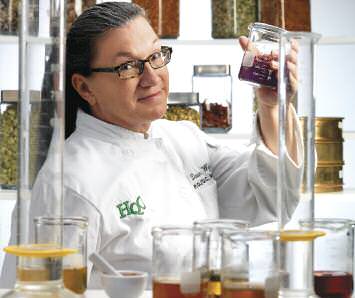cover
SPICE SLEUTH
Dawn Wykoff relishes deciphering tastes, at work and home.
WRITTEN BY ANN LINDEMANN
PHOTO BY JEFF ROSS
Whether she’s enjoying a simple lunch out with co-workers or noodling around with a recipe in her home kitchen, Dawn Wykoff can never completely clock out from her job at High Quality Organics.
“It’s hard for me not to try to figure out just what spices are in a given dish,” admits Wykoff, HQO product development and quality control manager. “And at home, I’m always experimenting and playing around with spices like a kid in a candy shop.”
Wykoff is a super taster. About 25 percent of us can lay claim to this same title, which essentially means that a person experiences the sense of taste with far greater intensity than average. The cause of this heightened response is unknown, but many say it’s due to an increased number of taste buds.
Still, super tasting powers are just one of the many tools that this food scientist uses each day at HQO, where she oversees food safety and helps develop new products and proprietary blends. Wykoff insists her educational background — an applied science degree in culinary arts and food service technology from the University of Nevada, Reno and a Washoe County food protection manager certification — is key to her success at HQO.
“In order to truly have superior products, we must have equally strong creative culinary and food safety expertise,” says Wykoff, who has been with HQO since 2007.
Wykoff and her staff of spice sleuths implement reverse-engineering techniques when a client presents a spice blend that he or she wants duplicated. Interestingly, the tongue is just part of the tasting process. The tongue — even that of a super taster — can only distinguish five distinct qualities, while the nose can distinguish hundreds of substances.
“I encourage my staff to think of what that spice reminds them of,” she says. “Using an adjective they are linking memory, smell, and taste. For instance, when I smell white pepper, it’s barnyard and manure. With that memory connected to that spice, I always know when white pepper is in the mix. You are working at identifying easily remembered flavor profiles.”
Spice Testing
With a scientific nod to this olfactory two-step, Wykoff and her staff members use what’s referred to as the “cupping process.” Basically, each product is put into warm water and steeped before it’s tested. Wykoff says this is an exacting process that ensures that the food scientists are comparing apples to apples.
Importantly, “cupping” allows them to observe the appearance of the product (the particulate), the smell (aromatics), and the taste (flavor).
“We use a ‘tea’ because it brings out each of these elements in the purest way possible — comparing it to what a blend might taste like in a cooked dish,” Wykoff says. “Cupping is critical to the integrity of our research and development and quality-control process.”
Wykoff admits that some spice blends are easier than others to decipher. Take, for instance, yellow curry.
“So it’s a sure thing that there’s probably coriander, fenugreek, and turmeric in it, but then I’ll have to use process of elimination to figure out the rest,” she says. “Curry recipes are passed down generation to generation; there are unending numbers of curries based on individual family recipes.”
With new spice varieties discovered daily, Wykoff is constantly adding another item to her ever-burgeoning sensory archive. But when a co-worker chides her about her highly developed olfactory system, Wykoff throws up her hands and laughs.
“You know,” she says, “sometimes a bowl of soup is just a bowl of soup!”
Are you a super taster? Find out here http://www.Psychologytoday.com/blog/comfort-cravings/201006/are-you-supertaster-mindless-eating-your-taste-buds.


